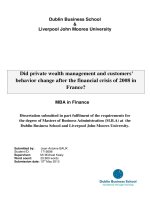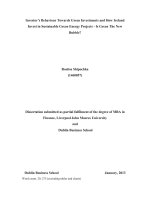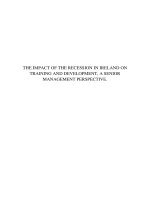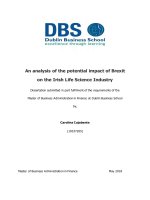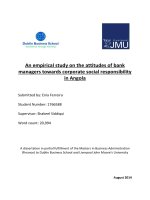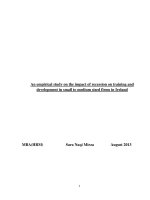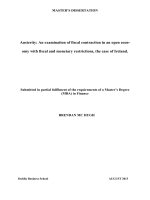Master Thesis in Economics: Estimating the Demand for a Direct Flight between Brazil and Ireland: A Preliminary Evaluation
Bạn đang xem bản rút gọn của tài liệu. Xem và tải ngay bản đầy đủ của tài liệu tại đây (2.37 MB, 94 trang )
Estimating the Demand for a Direct Flight between
Brazil and Ireland: A Preliminary Evaluation
Silvia Montagna Bertinetti Dantas
Student number: 10171358
Supervisor: Enda Murphy
Word count: 19.008
Master of Business Administration
Dublin Business School
August 2015
1
Declaration:
I, Silvia Montagna Bertinetti Dantas, declare that this research is my original work and that it
has never been presented to any institution or university for the award of Degree or Diploma.
In addition, I have referenced correctly all literature and sources used in this work and this
work is fully compliant with the Dublin Business School’s academic honesty policy.
Signed: Silvia Montagna Bertinetti Dantas
Date: 21/08/2015
i
Acknowledgements:
I would like to express my sincere gratitude to every person who made this dissertation
possible.
My supervisor, Enda Murphy, for his guidance, advice and support throughout the
dissertation process.
My family for all their support and encouragement and for being proud of my achievements
even from a distance.
My lectures and classmates, from all different modules, for sharing information, knowledge
and ideas during the MBA.
My partner Gerard for his love, patience, encouragement and support from the very
beginning until the very end through discussing ideas, proofreading and calling me out during
my procrastination moments.
“The process of scientific discovery is,
in effect, a continual flight from wonder”
– Albert Einstein
“When everything seems to be going against you,
remember that the airplane
takes off against the wind, not with it”
– Henry Ford
ii
Abstract:
The topic of this dissertation is an estimation of the demand for the creation of a direct air
service between Brazil and Ireland.
Currently, no direct service exists, despite the growing community of Brazilians in Ireland
and the increasing trade links between the two countries. The development of relations
between Brazil and Ireland over the last fifteen years is described in the literature review,
which covers four topics: the increase in number of Brazilian students in Ireland, the growing
trade links between both countries, the efforts to develop tourism links between the two
countries and the economic effects of the creation of a direct air service between countries
based on a number of relevant case studies from the literature.
The primary research carried out in this thesis consists of two questionnaires administered
online, the first directed at Brazilians living in Ireland and the second directed at potential
Irish visitors to Brazil. These surveys investigate the demand, interest, price range and
possible destination airports for a direct air service between Brazil and Ireland.
Based on the first survey of three hundred Brazilians who are resident in Ireland and the
second survey of fifty-two Irish potential visitors to Brazil, price ranges for the flight service
from both categories are obtained. A set of preferred destination airports are ranked based on
respondents’ answers and interest for a direct flight service is confirmed by both categories of
survey respondents. Quantitative results for each of the survey questions are presented in full.
A number of additional hypotheses related to the demographics of each set of respondents are
tested and limitations of the questionnaire and research methodology are discussed. Finally,
a number of recommendations are made for any airlines interested in offering a direct flight
service between Brazil and Ireland and future research on the topic.
iii
Table of Contents:
1. Introduction……………………………………………………………………………1
2. Literature Review……………………………………………………………………...4
2.1 Literature Review Introduction………………………………………………........4
2.2 Brazilian students community growth in Ireland………………………………….4
2.2.1
Introduction………………………………………………………………..4
2.2.2
Language students…………………………………………………………5
2.2.3
Science without Borders…………………………………………………...6
2.2.4
Demographics……………………………………………………………...7
2.2.5
Conclusion…………………………………………………………………8
2.3 Trade connections growth between Brazil and Ireland……………………………8
2.3.1
Introduction………………………………………………………………..8
2.3.2
Irish companies in Brazil…………………………………………………..9
2.3.3
Brazilian companies in Ireland…………………………………………...10
2.3.4
Irish bilateral trade with Brazil in recent years…………………………..10
2.3.5
Conclusion………………………………………………………………..11
2.4 Tourism growth perspective between Brazil and Ireland………………………...12
2.4.1
Introduction………………………………………………………………12
2.4.2
Irish efforts towards Brazilian visitors…………………………………...12
2.4.3
Brazilian efforts towards Irish visitors…………………………………...13
2.4.4
Conclusion………………………………………………………………..14
2.5 The economic effects resulting from the creation of direct flights……………....14
2.5.1
Introduction………………………………………………………………14
2.5.2
Summary of prior works…………………………………………………15
2.5.3
The case of Ireland and Brazil……………………………………………16
2.5.4
Conclusion………………………………………………………………..18
2.6 Literature Review Conclusion……………………………………………………19
3. Methodology…………………………………………………………………………20
3.1 Methodology Introduction……………………………………………………….20
3.2 Research Design………………………………………………………………….21
3.2.1
Research Philosophy……………………………………………………..21
3.2.2
Research Approach……………………………………………………….22
3.2.3
Research Strategy………………………………………………………...24
iv
3.2.4
Sampling - Selecting Respondents……………………………………….25
3.3 Data collection instruments………………………………………………………25
3.4 Data analysis procedures…………………………………………………………27
3.5 Research Ethics…………………………………………………………………..28
3.6 Limitations of Methodology……………………………………………………...28
4. Data Analysis and findings…………………………………………………………..30
4.1 Introduction………………………………………………………………………30
4.2 Questionnaire directed at Brazilian passengers residents in Ireland……………..30
4.2.1
Data analysis – Results from questionnaire aimed at Brazilians………....33
4.2.1.1 Hypothesis 1 – “Brazilians who are settled in Ireland (long-term in the
country) travel to Brazil at least once a year”………………………..33
4.2.1.2 Hypothesis 2 – “Brazilians who are married or in an established
relationship travel to Brazil more often”……………………………..34
4.2.1.3 Hypothesis 3 – “Brazilians living in Ireland would travel more often to
Brazil if there was a direct flight between the two countries”……….38
4.2.2
Most frequent hubs in trips between Brazil and Ireland…………..……..39
4.3 Questionnaire directed towards potential Irish tourists to Brazil………………...41
4.3.1
Data analysis – Results from questionnaire aimed at potential Irish tourists
to Brazil……………………………………………………………….….44
4.3.1.1 Hypothesis 4 – “Irish tourists who have never been to Brazil would be
more likely to choose the country as a tourism destination with the
creation of a direct flight between Brazil and Ireland”………...…….44
4.3.1.2 Hypothesis 5 – “Irish visitors who have higher annual household
income stay for a longer period in Brazil”…………………………...46
4.3.1.3 Hypothesis 6 – “Irish visitors who have higher annual household
income would be willing to pay more for a direct flight”……………47
5. Discussion……………………………………………………………………………49
5.1 Introduction………………………………………………………………………49
5.2 Hypothesis discussion……………………………………………………………49
5.3 Research question and sub questions…………………………………………….52
5.3.1
Sub question 1 – “What are the travelling habits between Brazil and
Ireland of Brazilians living in Ireland?”……………………………….....53
5.3.2
Sub question 2 – “What are the bilateral trade links between Brazil and
Ireland?”………………………………………………………………….53
v
5.3.3
Sub question 3 – “What is the current interest of Irish people regarding
Brazil as a tourism destination?”…………………………………………54
5.3.4
Sub question 4 – “What would be the economic benefits of the creation of
a direct flight between Brazil and Ireland?”……………………………..54
5.3.5
Research question – “Is there sufficient demand for the creation of a direct
flight between Brazil and Ireland?”………………………………………55
5.4 Limitations of research…………………………………………………………...56
5.5 Contribution of this project for the area………………………………………….57
6. Conclusions and recommendations…………………………………………………..58
6.1 Research recommendations………………………………………………………60
6.2 Practical recommendations……………………………………………………….60
6.2.1
Frequency of flights……………………………………………………...60
6.2.2
Ideal price range of flights………………………………………………..61
6.2.3
Cities to fly from/into Brazil……………………………………………..62
7. Reflection on learning………………………………………………………………..63
References……………………………………………………………………………….67
Appendices……………………………………………………………………………....72
vi
LIST OF FIGURES
Figure 1 - PPS numbers issued to Brazilian nationals in Ireland by year……………………..7
Figure 2 - Numbers for Irish Bilateral Trade with Brazil (Gurdgiev, 2015)…………………11
Figure 3 - The Research ‘Onion’ – Saunders et al. (2009)…………………………………...20
Figure 4 - Percentage of short-term Brazilian residents in Ireland x number of return flights
taken last year………………………………………………………………………………...33
Figure 5 - Percentage of long-term Brazilian residents in Ireland x number of return flights
taken last year………………………………………………………………………………...34
Figure 6 - Percentage of Brazilian residents in Ireland and their respective relationship status
x 0 return flights taken last year……………………………………………………………...35
Figure 7 - Percentage of Brazilian residents in Ireland and their respective relationship status
x 1 return flights taken last year……………………………………………………………...36
Figure 8 - Percentage of Brazilian residents in Ireland and their respective relationship status
x 2 return flights taken last year……………………………………………………………...36
Figure 9 - Percentage of Brazilian residents in Ireland and their respective relationship status
x 3 or more return flights taken last year……………………………………………………..37
Figure 10 - Percentage of Brazilian respondents who are in a serious relationship x number of
flights taken last year…………………………………………………………………………37
Figure 11 - Creation of a direct flight between Brazil and Ireland and the travelling habits of
Brazilians……………………………………………………………………………………..38
Figure 12 - The most frequent routes used by Brazilians when travelling between Brazil and
Ireland………………………………………………………………………………………...39
Figure 13 - Map of the most frequent hubs chosen by Brazilians when flying between Brazil
and Ireland and respective route lines………………………………………………………..41
Figure 14 - Percentage of Irish potential visitors to Brazil who never visited the country
before and their opinion about the creation of a direct flight………………………………...45
Figure 15 - Percentage of Irish potential visitors to Brazil who had been to the country before
and their opinion about the creation of a direct flight………………………………………..45
Figure 16 - Annual household income in relation to period of stay in Brazil……………….47
Figure 17 - Annual household income in relation to price willing to pay for a direct flight
between Brazil and Ireland…………………………………………………………………...48
Figure 18 - Kolb’s learning styles, adapted and designed by Alan Chapman (2005), based on
Kolb’s learning styles (1984)………………………………………………………………...63
vii
1. Introduction
This research project seeks to estimate the demand for the creation of a direct flight between
Ireland and Brazil and to investigate the travelling habits of Brazilians living in Ireland and
potential Irish tourists to Brazil.
Although the two countries do not share a common historical link in contrast with the Irish
links to the neighbouring South American countries of Chile and Argentina (McGinn), in
recent years Ireland has seen an influx of Brazilian nationals, first in Gort in Co. Galway,
which has resulted in the development of a thriving Brazilian community in the West of
Ireland (Sheringham, 2009), and secondly in the urban areas of Ireland.
The reason for the initial influx into Gort was due to a business deal between a meatprocessing plant in Central Brazil and an Irish factory owner in 1999 which led to a number
of Brazilians coming to Ireland to work from the State of Goias in Central Brazil.
The second wave of Brazilian nationals arriving in Ireland came as a result of the English
language school industry, mainly located around urban areas, which attracted students away
from the traditionally popular English-speaking countries such as the UK, USA and Canada
due to an attractive model of studying with the option of part-time work during the studies
promoted by the Irish Government to aid the language school sector. (Browne, 2012)
Despite the fact that Brazilians are one of the largest growing non-EU communities in
Ireland, there is currently no direct flight service between Brazil and Ireland. Several indirect
routes are available, the majority through European transit hubs such as Amsterdam Schiphol,
Paris, Madrid Barajas, Frankfurt or London Heathrow.
There are a number of existing direct flight connections between Brazil and Europe which do
not transit through the traditional air hubs.
Portugal is a popular destination for Brazilians due to historical and cultural ties and TAP
(Air Portugal) flies to many Brazilian destinations non-stop from Lisbon.
1
Another country with direct flight links to Brazilian cities is Italy, with charter connections
from Milan to the coastal cities of Recife and Fortaleza, both popular tourist destinations.
This study seeks to estimate the demand for the creation of a direct flight between Ireland and
Brazil, based on the primary data collected from questionnaires aimed at Brazilians currently
living in Ireland and at potential Irish tourists to Brazil. Complementary research about the
trade links between both countries, the efforts to promote tourism in each other’s country and
the economic effects caused by the creation of a non-stop air service, using as a starting point
examples from other countries, will also be examined in the literature review.
Although currently most intercontinental direct flights from Ireland are to countries such as
the USA and Canada, who have a stronger connection with the Irish diaspora, or emerging
transit and business hubs in the Middle East such as Abu Dhabi and Dubai, there are newer
non-stop destinations emerging, coinciding with demographic change in Ireland and Europe.
Recently, Ethiopian airlines announced that Ireland would be its European hub for transit,
although currently so-called “fifth freedom” rights, the right for an airline to pick up traffic,
will not be granted. (O’Halloran, 2015)
Therefore, the main research question for this dissertation is:
“Is there sufficient demand for the creation of a direct flight between Brazil and
Ireland?”
The sub questions to be answered during this research project are:
Sub-question 1 – “What are the travelling habits between Brazil and Ireland of Brazilians
living in Ireland?”
Sub-question 2 – “What are the bilateral trade links between Brazil and Ireland?”
Sub-question 3 – “What is the current interest of Irish people regarding Brazil as a
tourism destination?”
2
Sub-question 4 – “What would be the economic benefits of the creation of a direct flight
between Brazil and Ireland?”
This study does not intend to approach the legal, infrastructural and political related issues
that may be involved in setting up such a service, but only plans to estimate the demand for
the direct flights between the two countries and to predict the effects of the creation of this
service in the future.
Based on extensive surveys with Brazilians in Ireland, this work will attempt to estimate the
demand for such a service from their perspective, along with emerging demand for Brazil as a
tourism destination plus the growth in trade between Ireland and Brazil.
The economic benefits of non-stop flights can be underestimated however a study by
(Tveteras, 2014) found significant economic benefits, both direct and indirect, to a non-stop
service between Peru and Europe, for example.
This study will result in a comprehensive review of the demand and estimated outcomes of a
non-stop air service between Ireland and Brazil, which will be of great use for any airline
interested in planning and executing such a service.
3
2. Literature Review
2.1 Literature Review Introduction
This chapter will present the four main subjects to be observed from the secondary research
in this project related to the creation of a direct flight between Brazil and Ireland: the growth
of the Brazilian students’ community in Ireland, including a brief history of the first
Brazilians to move to Ireland, an insight into the Science without Borders programme and the
English courses pull-factor; the recent development of trade between Brazil and Ireland
presenting a brief list of Irish and Brazilian companies that are established in each other’s
countries; the focus on tourism development between the two countries and an analysis of the
effects caused by the creation of direct flights between two destinations, using as a
comparison two case studies presented in articles concerning Hawaii and Peru.
The analysis of these four subject areas combined with the primary research collected from
regular Brazilian travellers residing in Ireland and potential Irish visitors to Brazil will seek to
answer the research question of this project and estimate the demand for the creation of a
direct flight between Brazil and Ireland.
2.2 Brazilian students community growth in Ireland
2.2.1 Introduction
In 1999, the closure of a meat factory in Goias, central Brazil, coincided with the existence of
employment gaps in Sean Duffy Meat Exports based in Gort, Co. Galway in Ireland, which
was experiencing an economic growth during that period. An Irish entrepreneur living in
Brazil was the intermediate between the two countries and negotiated the immigration of
these first workers to Ireland. (Sheringham, 2009)
Following this successful process, more Brazilians from different regions along with their
families gradually came to Ireland to work in sectors such as construction, farming, fisheries,
manufacturing and the service industry, e.g hotels, restaurants, nursing homes, etc. This
movement occurred over many years, at its peak the number of Brazilians reached one third
of the total population in Gort. However, due to the recession suffered in Ireland in 2008, the
meat processing plant closed down causing losses of jobs and leading the majority of the
4
Brazilian community to return to their country of origin. (Sheringham, 2009, Maher &
Cawley 2014)
2.2.2 Language students
Since then, Brazilian students have chosen Ireland as an attractive destination to study
English. In comparison to other English speaking countries such as England, Australia, New
Zealand, Canada and the United States of America, Ireland offers a more generous option of
student visas which combines 25 weeks of full-time English language courses and the
possibility of part-time work that allows students to support themselves while living in the
country. (INIS, 2014)
The prices of English courses in Ireland, in comparison with the other countries mentioned
above, are also a competitive factor that attracts non-EU students, including Brazilians.
Regarding costs, another aspect that influences the choice of Ireland by Brazilian students is
that the amount that the government requires as a guarantee for the student’s subsistence is
€3000 for the period of duration of the course, while to study for the same period in London,
for example, would require a guarantee of ca. €8000 nowadays. (INIS, 2014) (UK Border
Control, 2015).
Furthermore, Brazilians enjoy the advantage of a visa waiver to travel to Ireland due to the
Immigration Act 2004 (Irish Statute Book, 2014), which does not require that students
coming from Brazil obtain a visa before entering the country.
After many years of an intense influx of Brazilian students seeking English courses in
Ireland, the Irish government recently announced future changes in the rules applicable to
non-EU students. These changes were motivated by the existence of irregular English schools
based in the country that could not reach the minimum standard of quality required by the
Irish regulation body ACELS (Accreditation and Co-ordination of English Language
Services).
These changes refer specially to the duration of the student’s permission to stay in the
country and the periods that work will be allowed throughout the academic year. (INIS,
2015). These modifications may impact the current scenario of Brazilian students attending
5
English courses in Ireland, and will also avoid scams from non-regulated English schools that
will promote the quality of English learning.
2.2.3 Science without Borders
Concurrently, in 2011, the Brazilian government created the programme “Science without
Borders” which funds Brazilian students to study science subjects to undergraduate,
postgraduate and research levels overseas. Since then, Ireland has proven to be a popular
destination for these students especially due to the influence of good experiences from
previous students in the country. (Hennigan, 2015)
Ireland currently has 27 higher education institutions participating in the programme and
received over 1000 applications from students starting the academic year in September 2015.
The Brazilian government has invested €50 million to cover tuition fees, accommodation and
the English courses for the academic students in Ireland. Also, an estimated extra €20 million
are spent by Brazilian students while in Ireland from private funds, which helps to boost the
economy around the programme. (Hennigan, 2015)
In 2014, Brazil’s president Dilma Roussef announced that Science without Borders, which
was initially planned to last until 2016, will be extended until 2018, offering an extra 100.000
scholarships to Brazilian students abroad. (Weber, 2014) Observing the good results of the
partnership between the educational organizations in the two countries, it is safe to say that
Ireland will remain as one of the favourite destinations for Brazilian students in the future.
In fact, in March 2015, Ireland’s Minister of Education and Skills, Jan O’Sullivan, went on
an education and trade mission to Brazil aiming to expand the connections between Irish and
Brazilian educational institutions. On this occasion the minister highlighted that Ireland is
currently the 4th most popular destination for Brazilian students registered in Science without
Borders in the world. (Irish Department of Education, 2015)
Another important partnership created is RBI (Research Brazil Ireland), a programme
launched in 2013 aiming to develop research and educational links between the two countries
with offices based in both locations. The focus of the project is on the priority areas of:
information and communication technologies, environmental science and technologies,
6
advanced materials and nanotechnology, biopharmaceuticals, biotechnology and health,
sustainable energy and agroproduction. (DCU Research, 2013)
2.2.4 Demographics
In a general analysis of the census data from the Department of Social Welfare, between 2008
and 2014, the number of PPS numbers issued to Brazilian nationals doubled from 4000 to ca.
8000. These numbers do not take in account the Brazilians that were already permanent
residents in Ireland before 2008. (See Figure 1)
PPS Numbers Issued to Brazilians
9000
8000
7000
6000
5000
PPS Numbers Issued to
Brazilians
4000
3000
2000
1000
0
2008 2009 2010 2011 2012 2013 2014
Figure 1 - PPS numbers issued to Brazilian nationals in Ireland by year.
These numbers also do not take into consideration the number of Brazilians in Ireland who
hold dual-nationality, normally of another EU member state, who would have PPS numbers
issued as European citizens and would also add to the number of passengers that travel
between Ireland and Brazil regularly.
A common fact is also that family members and friends are constant visitors to the Brazilian
students residing in Ireland. The students’ presence in the country generates an extra influx of
people coming from Brazil which boosts tourism and the economy while at the same time
strengthening the links between the two countries.
7
Another phenomenon that is commonly observed is that a number of Brazilian students that
originally came to Ireland with a plan to stay short-term found themselves settling down in
the country and constituting families with Irish nationals. This turns Brazilians into regular
travellers between the two countries accompanied by their family members who represent a
constant demand for a direct flight between Brazil and Ireland.
2.2.5 Conclusion
Based on the facts presented, the Brazilian students’ community in Ireland has shown an
increase in its numbers and represents a long-term established group. These students are
guaranteed passengers which, along with their respective visitors, characterize a stable
demand for the creation of direct flights between Brazil and Ireland.
2.3 Trade connections growth between Brazil and Ireland
2.3.1 Introduction
Brazil and Ireland established diplomatic relations in 1975. Since then the Brazilian Embassy
was opened in Dublin in 1992, followed by the opening of the Irish Embassy in Brasilia in
2001. (Department of Foreign Affairs, 2015)
Even though the relationships between the two countries are not recent, it was just during the
last few years, when the Brazilian economy observed an enthusiastic growth that Ireland has
developed economic interests in Brazil and both countries have begun to strengthen their
trade co-operation efforts.
According to Enterprise Ireland, Irish companies had a growth of 40% in exports of goods
and services to Brazil in 2011 (Enterprise Ireland, 2012) data which shows that Brazil
represents a key emerging market for Irish trade.
In 2012 over 40 Irish companies and educational institutions were represented in an Irish
Trade Investment Mission in Brazil, which aimed to establish contacts and business
relationships between the two countries. The outcomes were considered successful and
important new export contracts as well as business partnerships were established on this
occasion. (Enterprise Ireland, 2012b)
8
Even though the relations between the two countries are strongly based on the educational
sector, during the aforementioned Trade Mission, companies from a wide range of industries
which are interested in developing business relationships within the Brazilian market were
represented, including telecoms and software, financial services, engineering and
construction, consumer products and food ingredients. (Enterprise Ireland, 2012b)
Following this, in 2014, the Irish Exporters Association’s Latin America Trade Forum
(LATF) was launched to increase trade between Ireland and Latin American countries and to
serve as a resource for Irish companies that are interested in expanding their business to
countries like Brazil. (Rothery, 2014)
Also, the recent creation of a general Irish consulate in Sao Paulo (Brazil) in March 2015 and
the existence of Enterprise Ireland and IDA Ireland (Industrial Development Agency) offices
in the same city show the Irish government’s interest in establishing deeper diplomatic and
business relationships with Brazil, aiming to expand Irish penetration into the Brazilian
market. (Department of Foreign Affairs, 2015)
2.3.2 Irish companies in Brazil
There are a few examples of Irish companies that decided to invest in Brazil and are currently
established in the country.
One of them is Icon Group, a provider of outsourced services for the pharmaceutical industry,
which has been settled in Sao Paulo, Brazil since 2005, employs around 75 people and offers
services of clinical research, regulatory affairs, medical and safety services among others. It
has mainly developed studies in oncology, cardiovascular and metabolic research in Brazil
and represents one of the main companies in this sector in the country. (Icon Group, 2015 )
Kerry Group, a giant manufacturer of food ingredients, is another company which has
expanded its boundaries into the Brazilian market since 1999. The organization is solidly
established in Campinas, in the southeast of Brazil and opened a centre of excellence in the
country. (Kerry Group, 2015) IPM Group, an Irish company that produces and commercialize
9
varieties of potato seeds established IPM Brasil in 2012 and has its office also based in
Campinas, Sao Paulo. (IPM Group 2015)
Brandtone, an Irish organization specialized in International Marketing for mobile platforms,
has its focus on the emerging countries, including the BRICS (Brazil, Russia, India, China
and South Africa). The company is responsible for marketing campaigns of important brands
as Unilever and Pepsico and has its office based in Sao Paulo, Brazil. (Brandtone, 2015)
2.3.3 Brazilian companies in Ireland
Another example of both countries commercial interaction is the fact that the Brazilian food
group Marfrig acquired in 2008 the Northern Irish poultry company Moy Park. Since then,
the Brazilian food group has transferred the control of its European operations to Moy Park
and the Irish company currently represents 25% of Marfrig revenues. (Lowry, 2015)
Some Brazilian companies have also been strongly established in Ireland. One example is
ECC Leasing Company Ltd, Embraer SA’s wholly owned subsidiary, which was
incorporated in Dublin in 2002 and is responsible for managing and remarketing Embraer’s
pre-owned aircraft portfolio. (ECC, 2015)
Recently, in June 2015, Affero Lab, a Brazilian corporate e-learning company established its
European Operations Centre in Dublin and announced the creation of 40 highly skilled jobs
in the country. The negotiation is a result of IDA Ireland efforts which, as mentioned above,
has an office in Brazil and has worked to attract more investments between the two countries.
[IDA, 2015)
2.3.4 Irish Bilateral Trade with Brazil during recent years
Analysing the graph (Gurdgiev, 2015) below it is possible to see that from 1998 to 2014 a
constant growth in the numbers of imports and exports between Brazil and Ireland can be
observed.
According to Gurdgiev (2015) the Irish exports to Brazil dropped from €262 million in 2013
to €256 million in 2014, however the fall of 2.3% represented the exact same growth
10
occurred from 2012 to 2013, therefore the same level of exports can be observed in 2012 and
2014. The Irish exports to Brazil have experienced a cumulative growth of 21.2% over the
past five years. Due to a contraction in imports, the Irish trade balance with Brazil improved
in 2014. The trade in goods surplus for Ireland’s trade with Brazil in 2014 was €97million
while in 2013 a deficit of €12 million was observed which followed the deficit of €260
million experienced in 2012. This expressive deficit was caused by the record Irish imports
from Brazil which reached a 40% growth in 2012.
Figure 2 – Numbers for Irish Bilateral Trade with Brazil (Gurdgiev, 2015)
2.3.5 Conclusion
Observing the growth of the commercial interaction between Brazil and Ireland in the recent
years it is possible to affirm that there is also an increase in the demand for the creation of
direct flights to serve both countries business needs. The traffic of business people between
Brazil and Ireland is a logical consequence of the trade growth between the two countries.
Executives normally need to travel between places at short notice and in the most timeefficient way for meetings and events so the creation of direct flights between Brazil and
11
Ireland would serve this demand that has increased since the growth of the intense trade
between both countries.
2.4 Tourism growth perspective between Brazil and Ireland
2.4.1 Introduction
Tourism between Brazil and Ireland has increased in volume as a consequence of other
interactions involving both countries. The fact that Brazilian students became interested in
carrying out their education in Ireland and coupled with the fact that Brazilian companies
expanded their boundaries to the Irish market resulted in a raised awareness of Ireland as a
tourism destination as well.
As mentioned previously the influx of Brazilian students to Ireland generated an extra flow of
visitors including members of family and friends that travel to Ireland to visit these students
and represent a portion of the regular tourists welcomed in the country every year.
At the same time, Ireland has increased its focus on Brazilian tourists in the recent years after
the reports of the UNWTO (United Nations World Tourism Organisation) showed that
outbound tourism from Brazil has been growing sharply. In 2013, Brazil has also entered the
ranking of the top 10 countries in International Tourism Expenditure, with an increase of
13% compared with the previous year which translates into total expenditure of 25.1 billion
(USD) a year. (UNWTO, 2015)
Brazil, on the other hand, has invested in promoting the country as a tourism destination
overseas, through sport events and the natural and cultural attractions in the country that are
internationally renowned and have attracted visitors from all over the world.
2.4.2 Irish efforts towards Brazilian visitors
In an analysis of Tourism Ireland in 2012, it is stated that “Brazil has a young and rapidly
expanding population, with the emerging middle class now able to travel overseas for the first
time, thanks to a strong currency and easier access to credit.” (Tourism Ireland, 2012)
12
Furthermore, according to Tourism Ireland, while the number of Brazilian visitors is still
small compared to other markets as the UK, North America and Europe, long-haul tourists
such as Brazilians tend to spend more than the average and stay longer in the country
considering the distance travelled. (Tourism Ireland, 2014)
In 2013, Tourism Ireland invited Brazilian journalists along with representatives from other
members of the BRIC nations to visit Ireland and Northern Ireland. This was part of the
strategy of the government to increase the country’s exposure and the demand for Ireland as a
holiday destination for high-spending visitors from emerging tourism markets as Brazil.
(Tourism Ireland, 2014)
Other strategies have been presented by Tourism Ireland to attract visitors from emerging
markets like Brazil, such as co-operative campaigns with airlines and tour operators, a
version of the organization’s website in Portuguese and featuring Ireland in travel brochures
in Brazil. (Tourism Ireland, 2013)
2.4.3 Brazilian efforts towards Irish visitors
Brazil has also showed efforts to promote the country as a tourism destination for overseas
tourists. The country hosted the FIFA World Cup in 2014 which, during the months of June
and July, attracted attention from visitors all over the world, including Irish tourists. Even
after the World Cup, Brazil has enjoyed the benefits of the promotion generated by the event,
which in general aspects impressed visitors in a positive way.
Brazil will also host the Olympic Games in Rio de Janeiro in 2016, an event that will attract
athletes and visitors from all over the world, including the Irish Committee which has
confirmed its participation and has already announced the Team Ireland leaders which will be
in Brazil for the competition. (Olympic Council of Ireland, 2014)
Furthermore, according to the Irish Minister of State for Sport and Tourism, Michael Ring
TD, €1 million will be invested to assist the Irish athletes, coaches and service providers and
support their qualification, preparation and participation before and during the competition.
(Olympic Council of Ireland, 2014)
13
Brazil was represented in the Holiday World Show in the beginning of 2015 in Dublin, an
international tourism exhibition aiming to gather representatives from many destinations
around the world and to promote tourism among the respective countries. The Brazilian
Embassy has already confirmed presence in the 2016 edition which shows the constant
efforts of the Brazilian government to maintain the image of the country as an attractive
tourism destination. (Holiday World Show, 2015)
Another event organized by the Brazilian Embassy in Ireland and the Brazilian Tourist Board
– EMBRATUR was the “Brazil Travel Trade Workshop” held in the Dublin Chamber of
Commerce in June 2015. On this occasion, Irish tour operators, travel agents and specialized
travel media were invited to find out more information about Brazil as a tourism destination,
including presentations of representatives from Brazil’s tourist boards and workshops with
tourism suppliers. (Dublin Chamber of Commerce, 2015)
2.4.4 Conclusion
Analysing the strategies adopted by Brazil and Ireland to promote the tourism between the
two countries and observing the potential opportunities for tourism in these markets, the
question of the non-existence of direct flights between the two destinations arises.
This research projects aims to investigate the demand for the creation of direct flights
between Brazil and Ireland and the tourism motivations between the two countries is an
essential factor to answer the research question proposed.
Moreover, one of the objectives of the primary research conducted in this project is to
investigate the opinion of Irish tourists regarding Brazil as a tourism destination and the
effects that the creation of a direct flight between the two countries would have in their
decision to travel to Brazil.
2.5 The economic effects resulting from the creation of direct flights
2.5.1 Introduction
14
Globalization has made tourism more accessible to most travellers, however tourism
destinations such as Brazil are still considered exotic due to the fact the country is
geographically distant from key markets as Japan, United States of America and the EU
countries, including Ireland. Furthermore, “since travel cost increases with distance, faraway
destinations continue to be out-of-reach of many tourists’ travel budgets.” (Tveteras, 2014)
In this scenario, travel cost includes not only the air fare cost but also the costs related to time
spent and the convenience of travel as mentioned by (Tveteras, 2014) based on previous work
by (Gronau, 1970; De Vany, 1974; Anderson and Kraus 1981). At the same time, travellers
which have high salaries but with reduced number of holidays tend to prioritize a shorter
journey time even if this route would cost more. Executives travelling for business are also
included in this category. (Tveteras, 2014)
In this section, two prior studies related to the establishment of direct flights between two
destinations are summarised and analysed and their findings are examined in relation to the
current scenario of non-stop air service between Brazil and Ireland.
2.5.2 Summary of prior works
(Tveteras, 2014) examines the indirect and direct economic effects of a non-stop flight
connection between countries, in their case, Peru and France. They estimate tourist demand
using a series of variables including number of non-stop flights between destinations,
differences in purchasing power parity between countries and the distance between and
population of the countries. Having access to rich tourist number data from the Peruvian
tourist board, they quantify that with every 1% increase in the number of flights from a
European or American destination, there is a 0.3% increase in the number of visitors from the
country where the air hub is located.
“This indicates that by adding another long-haul flight from the Netherlands to Peru, the
increase in visitors to Peru will be 226, where 33 are visitors from the Netherlands (direct
effect) and 193 are visitors from other European countries (indirect effect).” (Tveteras, 2014)
In summary, (Tveteras 2014) finds that the increase in the number of international flight
departures to Peru has a marked positive effect on tourist arrival, however this was only one
15
relevant factor that should be combined with other actions to boost the tourism growth in the
country.
(Fujii et al. 1992) investigate the economic viability of direct flights from the US mainland to
the islands of Maui, Hawaii and Kauai in Hawaii. At the time of data collection, most of the
flights to the islands passed through Honolulu airport on the main island of Oahu which was
then the tenth busiest airport in the USA.
Their study focuses on the viability of the cost of extending the runways of the airports of
Maui, Hawaii and Kauai to accommodate larger jets, a cost which can be offset by increased
passenger numbers. They examine monthly travel data from 1973 to 1988 to fit their model,
finding that direct flights to Maui would be theoretically viable, however direct flights to
Kauai were found to be non-viable as they were cancelled after thirteen months in operation.
For the island of Hawaii, the passenger surcharge would need to be large ($120 per traveller)
to accommodate the runway modifications and would not be cost effective.
Compared to these studies, establishing the viability of a direct flight between Brazil and
Ireland would have a number of additional factors. These two studies mainly focus on the
tourist market, which is of interest in the case of Ireland and Brazil but also of interest is the
growth in commercial traffic and traffic related to Brazilian students and their families.
Infrastructure upgrades would be unlikely to be necessary in the case of Ireland and Brazil,
although this could indeed affect the relevant airports which would be chosen as destinations.
2.5.3 The case of Ireland and Brazil
As mentioned by Tveteras (2014), flights that exceed 3,000 kilometres are considered long
haul. The approximate distance between Dublin and Sao Paulo is 9,403 km, according to the
online service (Distance From/To, 2015) which uses Google’s Maps system to calculate
geographical distances.
The creation of a long haul direct flight between two destinations increases the transit of
people travelling between the two countries primarily because it normally reduces the travel
time but also because it incentivizes the competition with other airlines departing from the
main hubs to the same destinations which will drop the prices of airfares. (Tveteras, 2014)
16
As observed by Tveteras (2014), based on previous work by Lo and Lam (2004), first-time
visitors tend to be less concerned about the expenses involved in a trip and prioritize the
quality of the tourism, once they are not regular visitors to the country and the trip represents
a once-in-a-lifetime experience. Considering that, the creation of a long haul direct flight
contributes to the positive aspect of a trip and would incentivize Irish tourists to visit Brazil
for the first time.
Even though Brazil could still be classified as a developing country in economic terms, its air
connectivity can be considered fairly developed. As defined by Tveteras (2014), air
connectivity can be measured by the number of departing flights or by seat capacity.
Furthermore according to data provided by the ANAC (Brazilian National Agency for Civil
Aviation) in 2013 it was possible to fly to 58 destinations in 35 countries from 15 different
departing cities in Brazil. (Barbosa, 2013) However, Ireland is still not a destination which
can be reached by a direct flight departing from Brazil.
Brazilian and Irish visitors would primarily choose each other’s countries as a tourism
destination if there was a direct flight between the two countries. However, any visitor
travelling from Brazil to Ireland or in the opposite direction needs to make a connection in
another country, for example: England, Spain, Netherlands, France, Germany, Italy, Portugal
or even in Turkey or the United States. All these connections are not geographically
convenient options and this can result in tourists choosing a destination which can be reached
by a direct flight instead.
As well observed by Tveteras (2014), with the creation of a new long haul route, not only the
travellers in the country of departure benefit from this but the travellers from neighbouring
countries benefit also, which characterizes the direct and indirect effects respectively. In this
scenario, with the creation of a direct flight between Brazil and Ireland, it is not only the case
that more Brazilian tourists would visit Ireland but tourists from Argentina, Uruguay, Chile
and other South American countries who depend on flight connections in further hubs would
also benefit from this route.
Neither Dublin airport (DUB) nor Sao Paulo International airport (GRU), for example, would
need any expansion or major developments in their structures and facilities considering that
17


